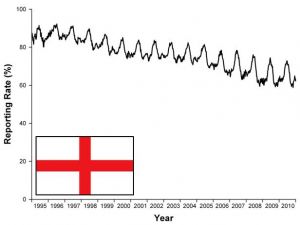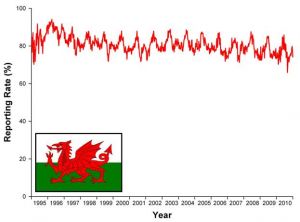World Sparrow Day: new results
BTO Garden BirdWatchers have charted the fortunes of House Sparrows every week since 1995. On average, during this period, almost one in four British and Irish householders who used to see House Sparrows no longer have them visiting. However, there have been big regional and seasonal differences. To try your hand at Garden BirdWatch, email gbw [at] bto.org and ask for a free three-week 'taster' pack.
Not in my backyard
While House Sparrow numbers have fallen across the board in gardens, some areas have been affected more than others. The decline has been steepest in England, with only shallow downturns in Welsh and Scottish gardens. Currently, there are relatively few Garden BirdWatch participants in Northern Ireland and the Republic of Ireland and so trends here are less robust, but early signs are that the problems facing House Sparrows are less severe here too.
The BTO/JNCC/RSPB Breeding Bird Survey monitors population trends of the nation’s birds across all habitats. Here, too, declines of House Sparrow have been steepest in England, but numbers in Wales, Scotland and Northern Ireland are actually on the up!
So, how can we explain these differences? Variation in habitat types may be important. England is more densely populated than Wales, Scotland, N.I. or Ireland, and it is especially in urban areas that House Sparrows have felt the pinch. Since gardens are, by their nature, annexed to urban habitat, this perhaps also explains why the long-term Garden BirdWatch trend for House Sparrows in Scotland in Wales remain slightly negative, despite the Breeding Bird Survey trend across all habitats in these countries going up.
Why the urban struggle? Feeding spaces for House Sparrows have been restricted by paving gardens for off-street parking, building on gardens (‘garden grabbing’) and use of decking. Research shows that House Sparrow breeding success improves in gardens with a high proportion of deciduous shrubs and a small proportion of concrete.
Nesting sites have also been lost, with many people now opting for plastic fascias and soffits instead of wooden ones, which would have gradually rotted, creating cosy nesting holes. Modern tiles also tend to be less arched, thereby providing less space under which House Sparrows can nest. Provision of House Sparrow nest boxes (e.g. House Sparrow terraces) could help to ameliorate this loss of nesting habitat. These terraces help these sociable birds to breed in close proximity to each other.
Seasonal differences
It is normal for the numbers of House Sparrows visiting gardens to vary seasonally, and between-season differences in the percentage of gardens occupied between autumn and the following summer have remained fairly consistent since 1995, Garden BirdWatch data show. However, between summer and autumn the drop in the percentage of gardens visited has grown from 3.8% between 1995 and 1998 inclusive, to 7.0% between 2007 and 2010 inclusive. It seems, therefore, that not enough young are surviving from the breeding season through into the colder months. This hypothesis is supported by data from the BTO’s Nest Record Scheme, which show a long-term reduction of brood size of House Sparrows from the 1960's.
If you enjoy watching garden birds and recognise your regular visitors, please help us by joining Garden BirdWatch or by emailing gbw [at] bto.org for a free taster pack.









Share this page